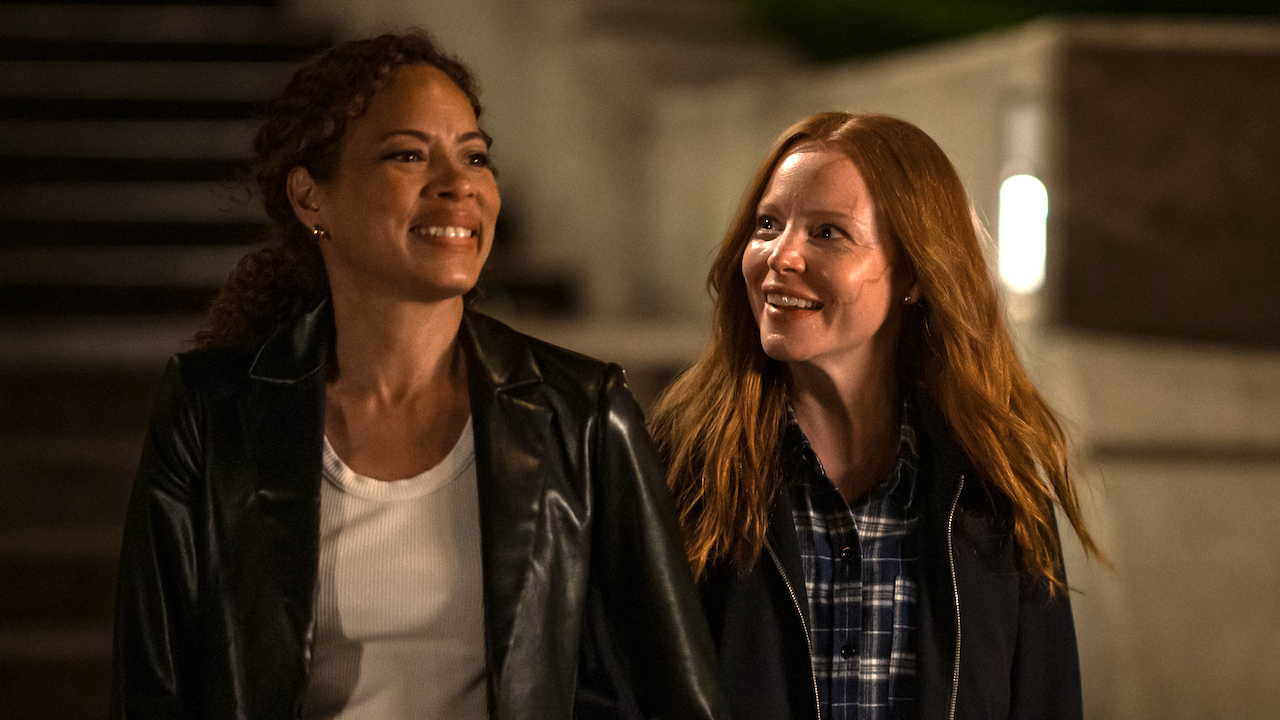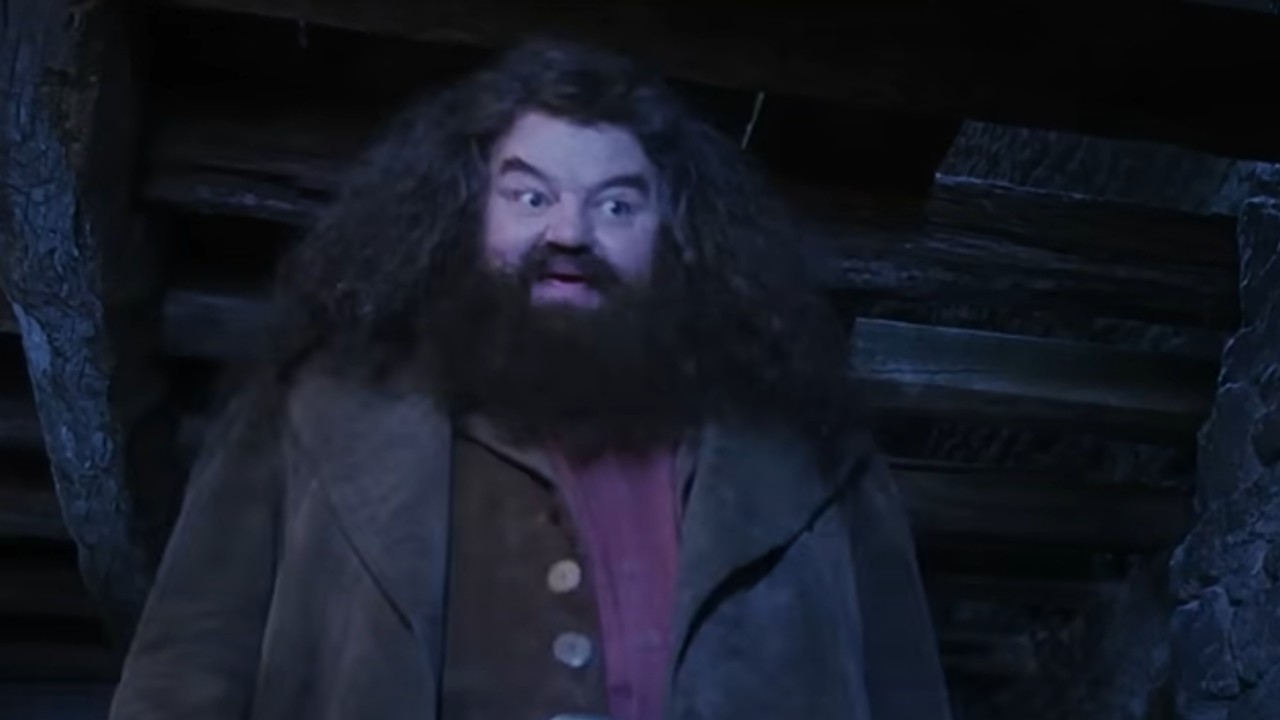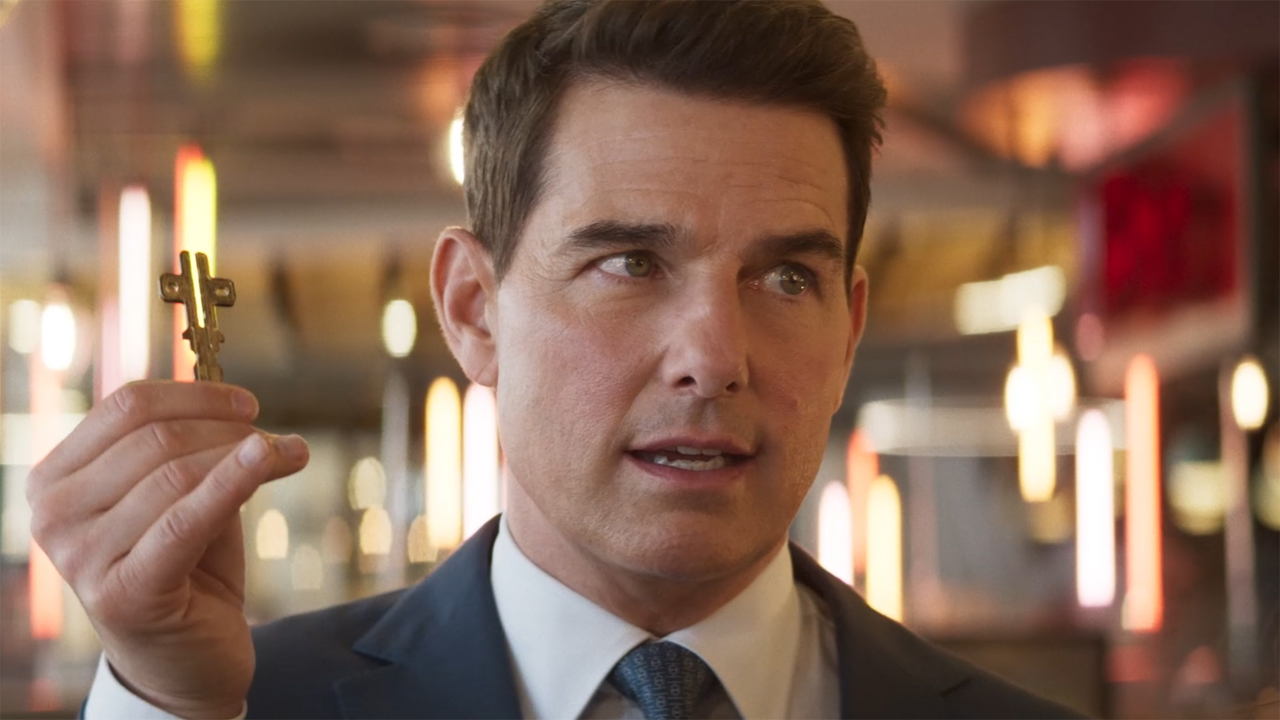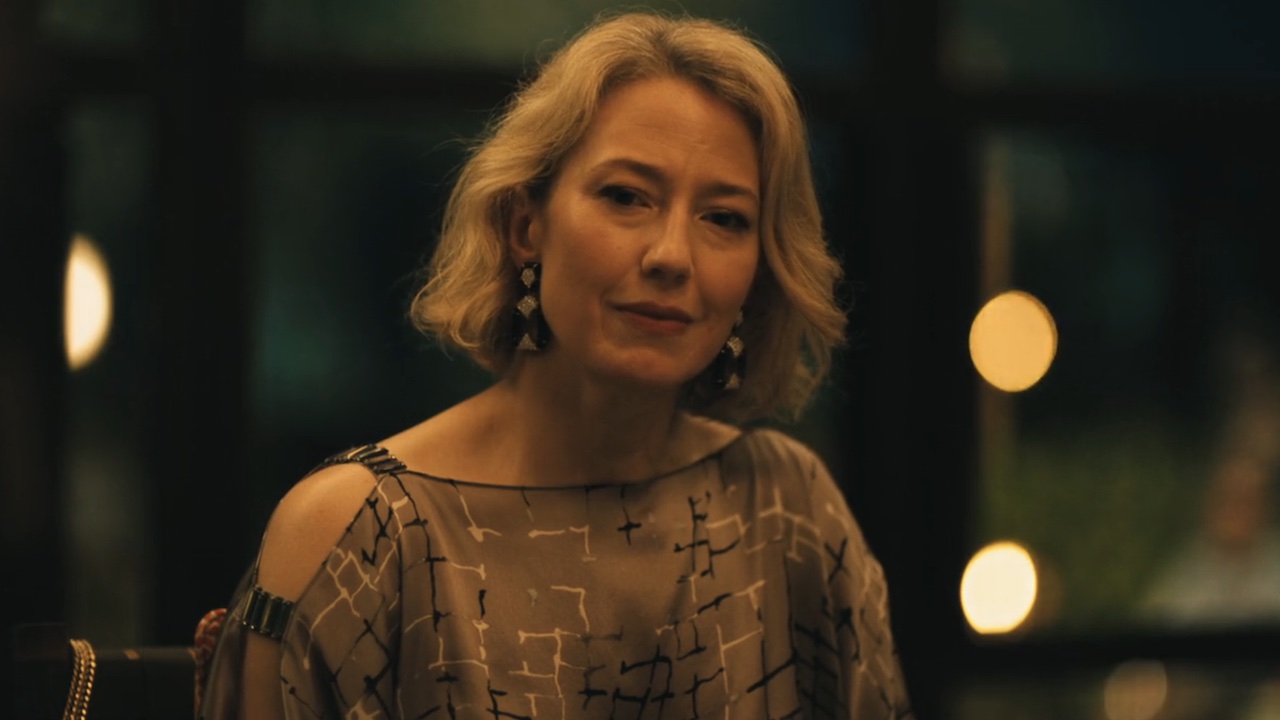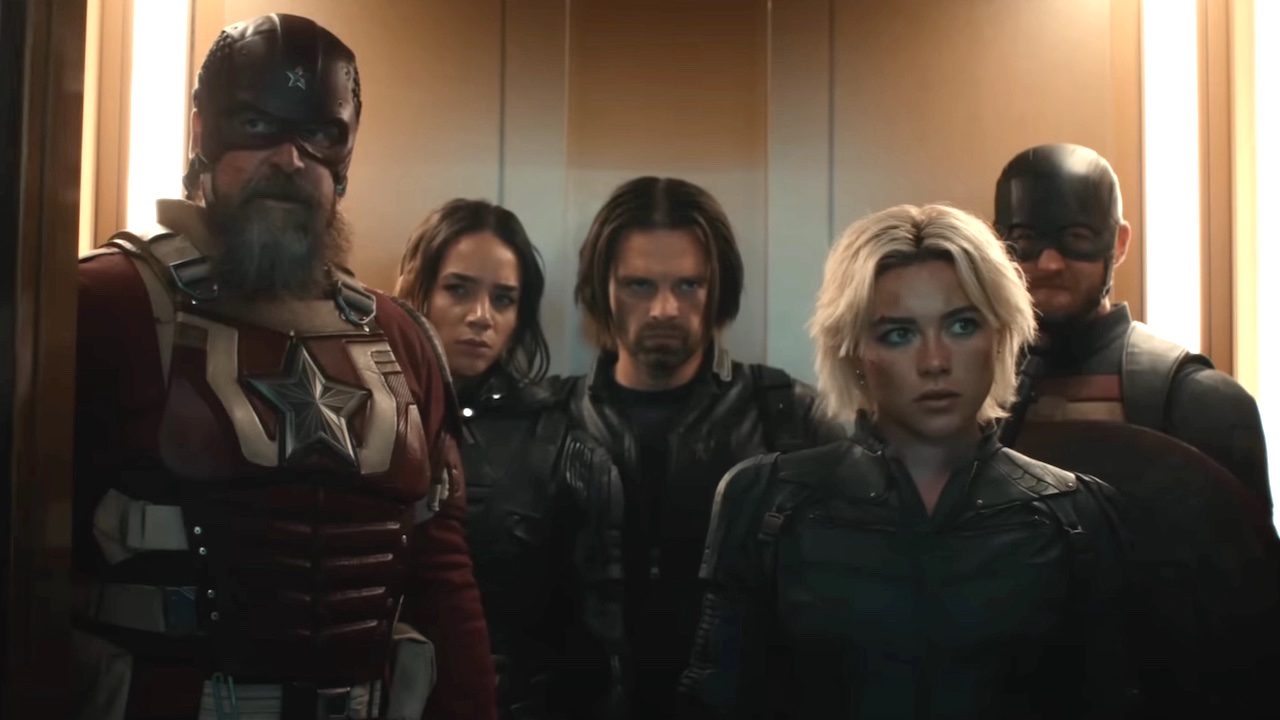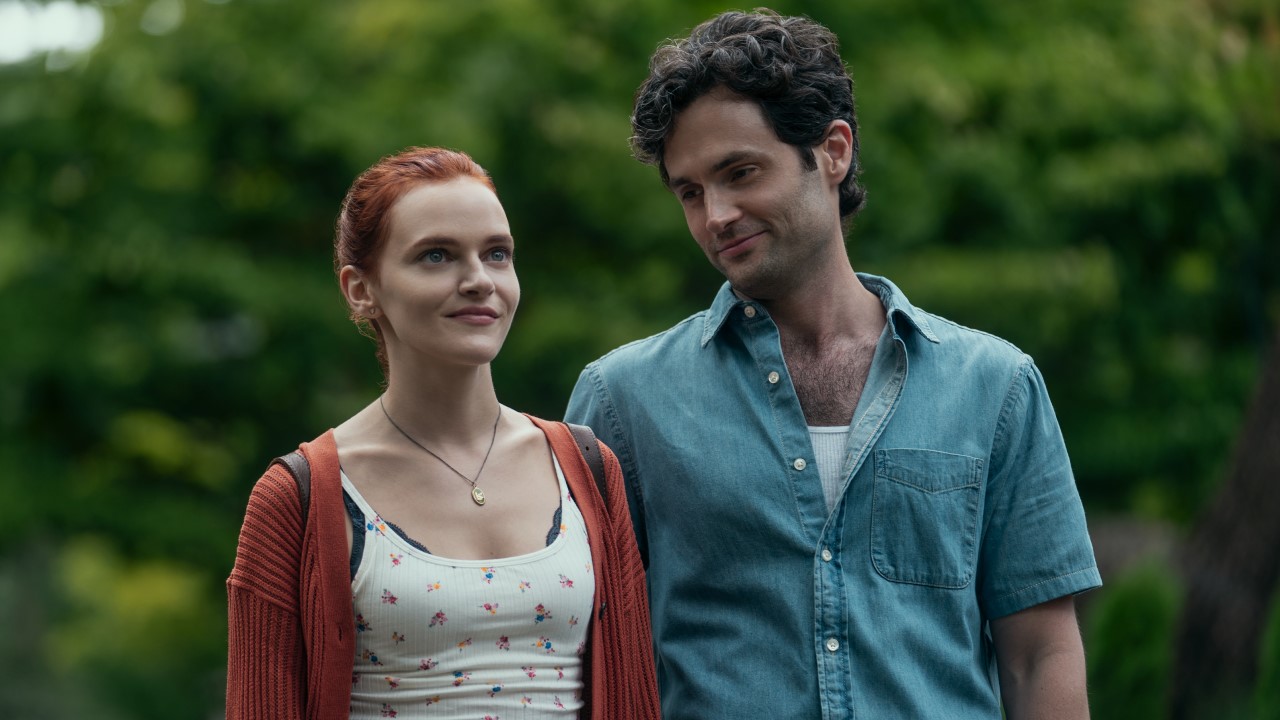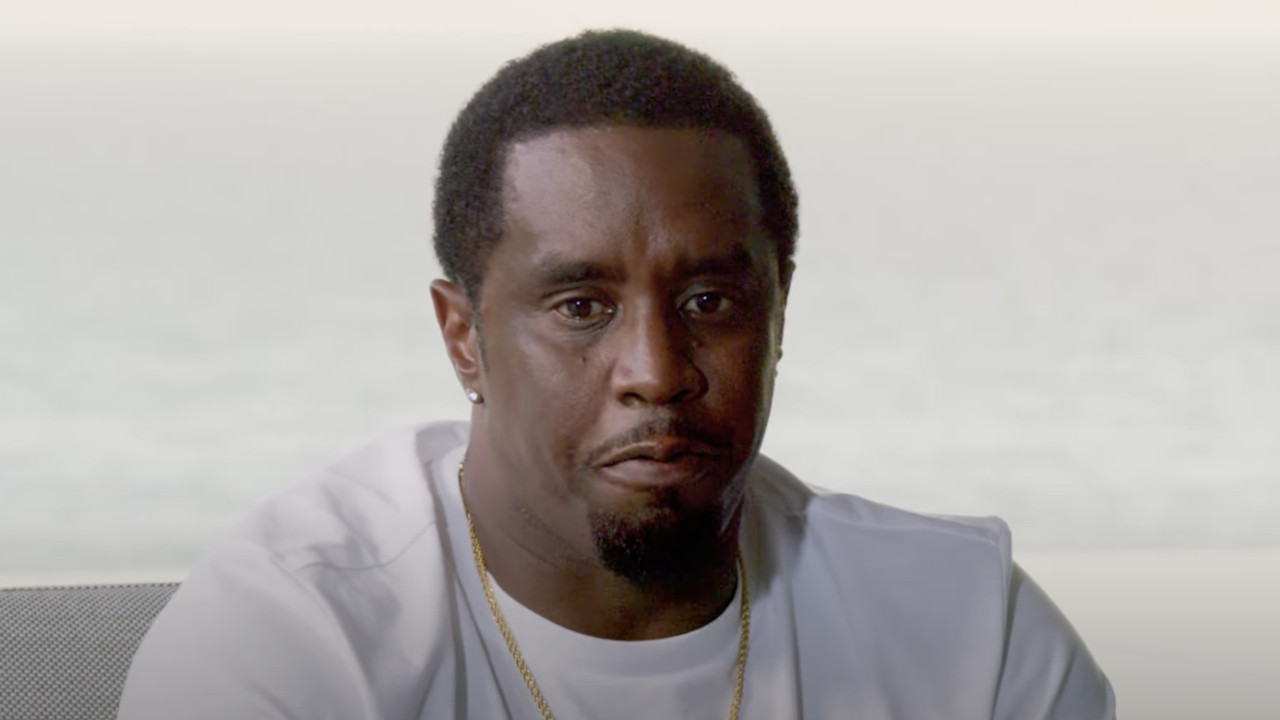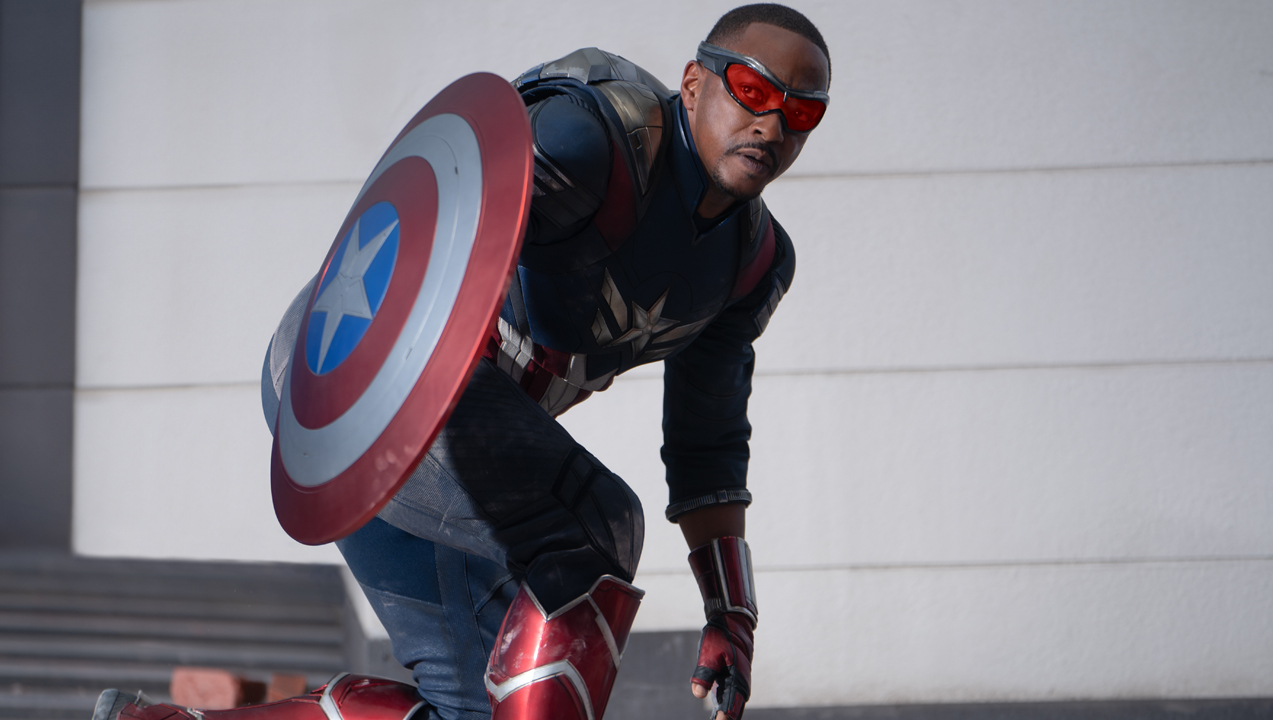Interview: Alice In Wonderland's Ken Ralston And David Schaub
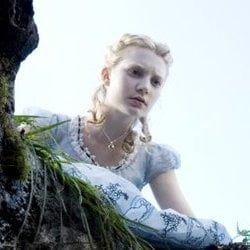
Whether you liked the movie or not, there's little question that Alice in Wonderland was a visual spectacle. In preparation for today's Blu-ray and DVD release, Disney invited journalists to sit down for a virtual roundtable with two of the men responsible for making Wonderland a wonder.
Visual effects supervisor Ken Ralston has over 30 years of experience in his field, stretching all the way back to his stint doing motion-control camera work on the original Star Wars. Animation supervisor David Schaub has spent over a decade working on films like I Am Legend, The Lion, the Witch and the Wardrobe, and The Polar Express. Ken and David sat after we had a chance to watch some of the special features from Alice and took our questions on their craft in general and Alice in particular.
Ken, you already had experience in other 3D films like Beowulf. Alice was not filmed in 3D, but then switched to this system. How does this affect the visual effects of the movie? How complicated is the process?
Ken Ralston: It actually makes the visual effects simpler because of the difficulty in putting 3D effects in a two-camera stereo shoot. The process is very complicated. You have to break down all of the separate elements in a shot with mattes and project imagery onto 3D CG shapes that replicate the action in the shot.
Ken, does working with a green screen change how you approach things?
Ken Ralston: Green screen or blue screen is basically the same idea for compositing live action into visual effects. But the green-screen color, after long periods of time, seems to create a certain aggravation and irritation after staring at it for a long period. It is effective for compositing, but visually and psychologically exhausting to be surrounded by it for extended periods of time. The overall concept of shooting against green screen enabled us to design our sets and environments after the live action shoot. So it gave us great flexibility.
Dave, which character was the most difficult to animate?
CINEMABLEND NEWSLETTER
Your Daily Blend of Entertainment News
David Schaub: Each character had its own unique challenge. From a technical perspective, Stayne was incredibly tricky, since every shot required an animated CG body underneath a photographic element of Crispin Glover's head. Creative challenges were the Cheshire Cat and getting the essence of the "creepy" nature of a cat and what that all meant from Tim Burton's perspective. "Creepy, quiet and ...STILLNESS (not over-animated)" was the directive.
In addition to the obvious "fanciful" characters, we also animated all of the animals -- really all the "non-human" characters in the film. While we have a lot of creative freedom for the "fanciful" characters (like the Cheshire Cat, March Hare, Caterpillar), animating realistic animals always presents a challenge since everyone knows precisely how a horse or a dog moves...there is less wiggle room for a creative stretch, and if it isn't right, the animation stands out like a sore-thumb.
Ken, was is difficult to define the character of the crazy White Rabbit? Ken Ralston: I believe you are asking about the March Hare. It was difficult trying to come up with a performance that Tim Burton liked that gave us the insanity of the March Hare without having it overact. Basically, it is difficult telling animators not to overanimate! Especially with a character like the March Hare that is exaggerated and over the top.
David, the film features a collection of characters well known to all lovers of animation. How does this affect your work? Did you take the work done in the animated movie Alice in Wonderland from Disney as a reference?
David Schaub: We drew on all kinds of references, and certainly the Disney version of Alice was one of our first go-to's. From a design perspective much of the influence came from the original John Tenniel illustrations. We tried many different animation styles during our preproduction phase, from the very cartoony to the very refined. In the end, Tim gravitated back to a very grounded and very subtle style of animation. The important thing was to make sure that these characters resided in the same world as their live-action counterparts. We took many of our cues from how Tim directed the actors on set...very subtle performances that were not over-dramatized in any way.
Ken, Alice came up with more than 1,700 VFX-Shots. How important was the whole pre-visualization process to cope that massive project?
Ken Ralston: There wasn't as much pre-visualization of the project as you might expect. Only the action sequences, like the Bandersnatch chasing Alice, and sequences with less actor input, were the ones that could be pre-visualized. The nature of this project was that we had simple versions of the environments available on the set, which allowed Tim and the actors to have the flexibility to create the scenes and action on set.
Ken, how was it to work with Tim Burton? Were there any ideas you had for the movie that couldn't be done for technical any reasons?
Ken Ralston: Everything that Tim and I wanted is in the movie. Working with Tim was a great experience for me. Creatively I had more freedom on this show than on any one previously. It is great to work with someone who knows this kind of movie so well. We had a shorthand that allowed us to speed the process along. Basically, we are both nuts!
Ken, did you learn anything unexpected during the massive production process?
Ken Ralston: Nothing was really unexpected. After doing these kinds of movies for so long, I was able to anticipate many things and be prepared. It is great when a plan, especially a big, complicated plan like this, comes together. I had a great team of super-geniuses backing me up at every turn.
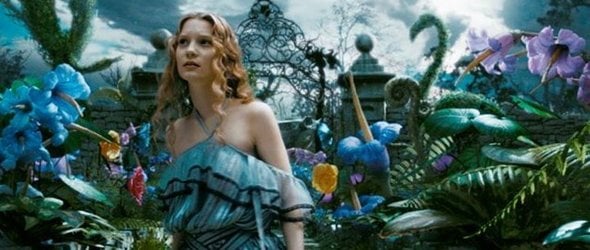
Ken, when a movie is shot in 2D using one camera, visual effects are not inserted yet; does the visual effects supervisor need to have the photographer making special choices during shooting to be able to apply good 3D effects on a 2D source?
Ken Ralston: During Alice, I was on the set every day, working morning to night with Tim and the director of photography, Darius Wolsky, making sure that everything shot would come together in post. But we really made no concessions of the 3D aspect of the film and shot it basically like any 2D movie.
Ken, the film was filmed using green screen. Was it particularly difficult to recreate all the environments with CGI, taking into account the style of Tim Burton that is so overloaded with details? What kind of challenges did you find in this regard?
Ken Ralston: It was very difficult. Every shot in every scene has many details and textures in the environments. The real difficulty is the size of the data and the rendering of the shot -- and the time it takes to do all of that -- had to be calculated to take that into account in our schedule.
David, how much input did you have in creating the personality of the laid-back Blue Caterpillar?
David Schaub: I think Alan Rickman's performance pretty much dictated the essence of that character. He had such disdain in his voice, and the performance came across as such by shear virtue of his read. Tim was great about letting us try different things. The smoke was such an integral part of that character. We did everything we could to have him interact with the smoke as he swirls the mouthpiece of his hookah and watches the smoke rise. It was a way to ground that character in that world in a very quiet, still, and controlled way...much like the mandate for all of these characters. Again, that would be "refined animation" without overacting.
Ken, has the Blu-ray image quality forced you to be more meticulous with visual effects in any way?
Ken Ralston: The Blu-ray image is actually equal to the resolution at which we work. So what you see on Blu-ray is the same as what you see on the big screen and the same as what we see here at Imageworks when we are viewing dailies and making the shots. We are trying to produce the most perfect image, and Blu-ray maintains that image quality.
Ken, with today's technology have you reached a point where everything you can dream of is possible? If not, what one or two things can we still not accomplish?
Ken Ralston: We will never reach the ability to do absolutely everything. As artistry and technology keeps advancing, the demands on it keep growing. As long as there are inventive filmmakers who keep pushing the envelope as we do, thank God, we will always have new challenges.
David, do you both think that the movie will have the same impact without the stereoscopic 3D-effects? What’s you general opinion about the stereoscopic-wave?
David Schaub: I certainly think the movie stands on its own as a 2D creation -- which it was. We truly did the work thinking in terms of a 2D creation, with the most important thing being story and bringing the Tim Burton vision to life. The 3D aspect was icing on the cake on the back-end, at least from my perspective. My point is that the 3D aspect did not "burden" the filmmaking process.
In the film we can see CG characters with motion capture, but also some characters partially animated, using motion capture, but using real parts of the actors. What can you tell us about these? What kind of challenges did you find with them?
Ken Ralston: To be clear, there are no motion-capture characters in the film. They are all animated. As protection, we did capture motion, which was useful as a guide for the animators. For the hybrid characters, such as the Tweedles, we wanted to maintain the brilliant facial performance of our actor, which could never be duplicated by a CG interpretation.
David Schaub: Motion capture became a point of reference for us in the end. If you watch the performances of the actors on set -- often on stilts (and moving that way), you will see that the essence of movement in the final scene is very different. That is because the performances were animated. We went into this shoot not knowing all the details of how it would shake down, so we covered ourselves by acquiring motion capture, as well as optical data (that's what those big white/black targets are on their suits). The actors are directed on set to hit their marks, moving from A-to-B and delivering a performance that we ultimately used as reference for animation. If you look at the way the Tweedles move, it is indeed the essence of Matt Lucas' performance -- but it is also stylized in a way that is very different than the way they moved on set. This was a deliberate style choice that evolved once we got into animation. The faces were also fully animated with animation controls, but for an extra level of realism, the eyes and often the mouth were tracked back into the final render. We had to nail those facial performances precisely.
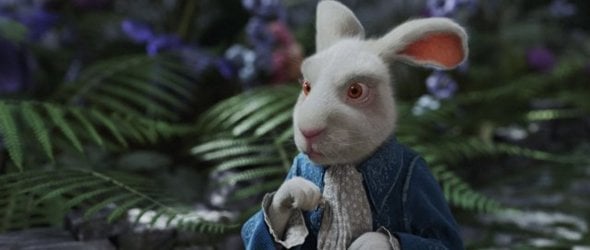
David, have the animations been created for 2D and then taken to 3D with the whole movie process, or have they created directly for 3D?
David Schaub: The live-action characters (like Alice, the Red Queen, Mad Hatter) were converted to 3D, while the CG characters were native 3D in our virtual worlds. From an animation perspective, they were animated like any other CG character, then rendered through left- and right-eye cameras. The tricky part comes into play when a CG character is interacting with a live-action character. The photographic element of the live-action character must first be "rotomated" in the scene (essentially a CG stunt-double) so that photography can be projected back onto that character. Once a 3D representation of that character is in the scene, the CG characters can interact with that live-action character -- keeping depth registration in mind. We now need to take into account the Z axis -- not just X and Y like in a 2D film.
Ken, what is your favorite visual effect of all time -- one that you did not do but really admire?
Ken Ralston: Excellent question. The Skeleton Fight by Ray Harryhausen seen in Jason and the Argonauts is my favorite visual effects sequence. This scene, more than any other, stands out as one of the greats of all time.
Ken, what was the technical reason that Crispin Glover had to walk on stilts? Did it provide a greater realism or was there another reason?
Ken Ralston: The main reason that Crispin Glover walked on stilts was to place him at seven feet tall so that the eye-lines with all of the other actors would be accurate.
David, how much training was involved in putting the actors on stilts?
David Schaub: They spent several days hobbling around the set trying to get the hang of it. The primary reason for putting them on stilts was to get the eye line right on set. You'll notice that the movement of an actor on stilts looks like an actor on stilts, so those performances were really used as a point-of-reference for animation. The animated version of the Tweedles, for example, has a different feel about them than what was actually shot. That was a stylistic choice that evolved with Tim over the course of the show.
David, for Tweedeldee and Tweedledum you combined footage from faces of a real actor with CG-figures. Who came up with the idea for that and how difficult was it to animate, control, and combine the facial expressions?
David Schaub: That was Tim's idea, and it is something that Ken Ralston always wanted to do; that is, combining live-action elements of a face in the render.
David, CG Cheshire Cat is one of the most impressive and most well-known characters from Alice. Could you explain the technical challenges regarding the animation process of the Cat?
David Schaub: The eyes and mouth were certainly the biggest challenges. The eyes are so prominent, and we were able to control all of the dilation attributes to make them as real as possible. Also, the smile was a challenge since it spanned from ear-to-ear. The inner palette had to deform as well, so that the teeth tracked along with the mouth through its full arc.
David, could you please name your favorite Wonderland inhabitant, maybe one that matches your own character?
David Schaub: My favorites changed through the entire process. You develop close attachments to characters as they develop, but it seemed like each sequence brought new and different challenges and new favorites. Cheshire Cat was probably the first favorite that I could identify with. By the end of the show I was clearly the March Hare -- completely frazzled!
Ken, is there any setting for a film that is difficult to pull off now with modern technology? Years ago, snow, for example, used to be a difficult setting to blend effects into realistically. Wonderland looked fantastic, but is there a type of setting that presents too many challenges?
Ken Ralston: The truth is no, I don't believe that there is a setting that is impossible to achieve. We have made large advances with many of the traditionally difficult environments and effects: water, fire, snow, etc., and continue to grow in those fields. Today, it is much more doable than ever before.
Dave, how did you first get interested in animation generally and what do you recommend for students looking to begin a career in your area of expertise?
David Schaub: I've always had an interest in animation for as far back as I can remember. Originally, it was Saturday-morning cartoons, but later it became the Disney classics. I was the kid that drew flip-books in the corner margin of my math book and was always doodling or fiddling with 8mm film projects of my own. My advice to any aspiring animator is to dive in head-first and get involved. There is really no better way to get good at this than to do it. Take every opportunity and make the most of it. There are some great schools out there, and we are seeing a lot of great talent coming our way as a result. In the end it really is about your reel, and a demonstration of your talent that makes an impression. The artistry is what matters, regardless of your particular education. But all that education certainly helps.
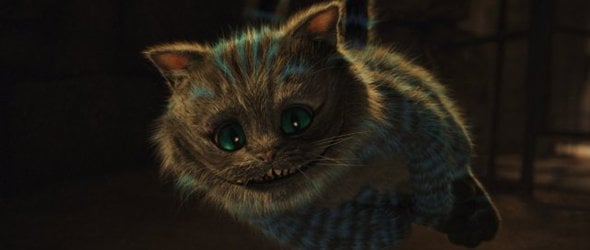
Ken, what was the best visual effect you ever did that no one realizes was a visual effect?
Ken Ralston: There are many. Contact was a movie that had many of these kinds of invisible shots. For example, the mirror shot, in which Jodie Foster as a child runs up the stairs, down a hallway and reaches into a medicine cabinet, is a complicated blending of elements that you have to look hard at to realize that what has occurred is impossible.
David, Blu-ray technology can bring to new life the old masterpieces of the past. Do you think old Disney classics will look as exciting in 2K resolution as to be appreciated as much as new animation movies?
David Schaub: I think the remastered Disney classics look amazing on Blu-ray! The level of detail that you see on the old cels is phenomenal -- you can even see the shadow of the cel against the background. It brings you up close and personal to that amazing artwork that has been so hidden in low-resolution renditions.
David, could you tell me a little bit about what it's like to work with Tim Burton?
David Schaub: Tim was absolutely great. He is such a visionary and an absolute pleasure to work with. He has an incredible visual sense, and any time that we got stuck in any way he would always have great ideas that would steer us in new and interesting directions. That vision took us places I never imagined we would go. He has great respect for all of his actors and artists, and truly manages to bring out the best of everyone involved. Because of Tim's involvement, I would have to say that it was one of the most rewarding shows I have ever been a part of.
Ken having worked with Robert Zemeckis, how successful do think mo-cap is as a solution to animation problems, and are you happy with the speed at which it's growing use in the industry?
Ken Ralston: Motion capture has a place in specific types of movies. It is one of many available tools. On Alice, we only used motion capture as a reference. All of the characters and animation were actually done through traditional key frame techniques.
Dave, how much leeway were you given to add your and your staff's own personal style of animation when there was also the look and visual style of Tim Burton that was being presented?
David Schaub: Tim was great at giving us lots of creative license to try lots of different things. He would always steer the work toward his particular sensibilities, and rather than completely scrap a performance that was working well in its own way, he would always find a way to make the most of the elements that worked and steer the ship forward without completely turning the ship around.
Ken, it's easy to think "Oh, it's all green screen," but how complicated were the physical green screen sets you built?
Ken Ralston: They are deceivingly simple looking, but the placement of all of the green props and elements were lined up exactly to the detailed CG designed sets developed by production designer Rob Stomberg. We also had to clothe stunt people, technicians, mechanical effects crew, and anyone who was visible in frame but not a principal cast member in green. We shot on two large sound stages where portions of sets were constructed. And the green screen also had extensive reference markers so we could track the cameras and know where we were in space.
Dave, were there any traditional camera tricks that helped as shortcuts in the animation process?
David Schaub: There weren't really any camera tricks that we could get away with on a film like this. The typical tricks that you could pull off in 2D would be revealed in 3D. For example, if you discover that a character is floating off the ground in your render, you could always cheat that contact with a contact shadow in the final comp. Since we are dealing with stereo cameras, all of those cheats reveal themselves in 3D; so we can't get away with too many camera "tricks."
Ken, as technology has advanced to the point where basically anything you can think of can be created on screen, do you think audiences are suffering from "CGI fatigue?" How do you continue to wow audiences who have, in some ways, seen everything already?
Ken Ralston: CG is a tool like any other tool in making a movie. It can be used correctly or abused. When used correctly, it can enhance the film's illusion and the audience experience. It is less about the technique and much more about how it is used. When used effectively to enhance a story, stunning visuals and the opportunity to explore something you have not seen is a rewarding experience.
David Schaub: The most important thing is to wow audiences with great stories and great performances. Yes, if a film hinges on spectacular VFX in order to keep the audience's attention, then it is very easy to get "CGI-fatigue" on a grand scale. Everything we did in this film was in support of the story, and bringing Tim's vision to life. It was never about creating some spectacular effect that no one had seen before... but the up side is that I think we ended up with some pretty unique things in the film that audiences have in fact not seen before!
Ken, this project mixes old and new techniques. Are there any new filmmaking technologies on the horizon that you're excited about or that you think will change the game in a big way?
Ken Ralston: I don't know there is something on the horizon that will change the game as much as it is about applying the best technique to get the director's vision onto the screen. Thank you for recognizing that we used a great variety of techniques. Change actually happens somewhat slowly in visual effects. Each film builds on what we learn from the last. While it may seem that certain films are a stunning breakthrough, the imagery is often the result of a steady progression accomplished over many years and through many films. Our technologies are continuously evolving.
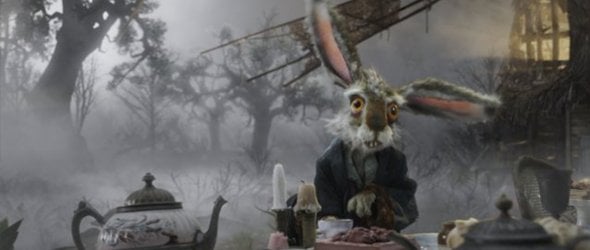
David, how many man hours are added with the hybrid characters, as opposed to having either live-action or fully animated characters?
David Schaub: The hybrid characters were particularly tricky -- mostly from a technical point of view. We did not have to make a huge creative leap regarding performances, because the essence of the performance is precisely how the actors performed their parts. Stayne was probably the trickiest in that regard because of his proportions. The trick was to replicate the essence of those performances -- precisely as Crispin Glover performed -- but also imparting a level of gracefulness to his moves, which were often difficult to accomplish on stilts. Hours? Many hours! It is just another one of the many animation challenges that we were presented with.
Ken, have you been surprised by the speed with which 3D has become the norm for blockbuster releases?
Ken Ralston: Maybe a little surprised, but it has been clear for some time that there was a growing appetite. The success of Avatar really demonstrated the potential of 3D and also accelerated the availability of 3D equipped theaters.
David, what was perhaps the biggest obstacle you had to overcome while filming Alice in Wonderland?
David Schaub: That looming deadline! Because it was to be a 3D release, our delivery date was inked in long before we knew the full scope of work. All we knew is that it had to be in theaters on March 5, 2010! There was no moving that date, and that meant that our animation schedule was nine months from start to finish, no wiggle room. You'll notice that actors are geared up for motion capture, and they also wear targets for an optical tracking solution as a backup should we need to go there. We went into this armed with as much as we could, and allowed for fallback plans as well. In the end, we went for a more stylized version of movement, which was more of an animation solution, but we didn't know that going in. We just had to be as prepared as we could for all the curve-balls that might come our way -- and we certainly didn't want to have regrets that we didn't capture data when we had the opportunity to do so.
David, what was the storyboard process like? Were the boards very detailed and specific? Or were they more loose and gestural, focusing on mood and general blocking?
David Schaub: Tim is a very visceral filmmaker...and really likes working with storyboards. It is a very interactive process when it comes to animation, and a lot of our performance cues were taken from how he directed the actors on set. When it came to the animation process, it was the typical round of blocking, primary, and secondary animation approvals.
Ken, what all went into the epic climax of Alice in Wonderland?
Ken Ralston: The end battle was shot entirely on green screen. We designed the Jabberwocky as an homage to Ray Harryhausen's work. There is a tremendous amount of animation and compositing. The sequence is full of many effects and animation tricks -- fog, dust, debris -- many, many small details that blend together to add a reality to the scene.
David, Alice has -- possibly unjustly -- been lumped in with a number of other blockbusters that have "upscaled" to 3D in post. How do you feel about the rush to the new technology? Do you feel some of the other films undermined what you had achieved?
David Schaub: We can always hope that the standards remain high. Of course, there is always the possibility that the work turned out over the next couple of years will dictate how the industry goes as a direct result of how audience react to the 3D conversions currently underway.
Ken, any final thoughts about working on Alice?
Ken Ralston: Working on Alice was the best experience I have ever had, and I think the best work that I have ever done, having had to accomplish a wide variety of illusions to make Wonderland work. And working with Tim was the ultimate creative experience.
Dave, any final thoughts about working on Alice?
David Schaub: It was truly one of the best creative experiences of my career. Working with Tim was amazing. He has such great ideas, and every time we hit an impasse he would steer us (or nudge us) in another interesting and unique direction that I would never have imagined. He is truly a creative genius, and an inspiration to work with. We also had the most amazing and talented group of animators I've ever had the pleasure to work with. Their artistry was second to none. It was a crazy accelerated schedule -- when you consider that animation was only nine months from start to finish. We knew that we only had this small window to make the very best of this unique opportunity, so everybody gave it everything they had -- and I believe the magic of the artists really came through. You don't get these amazing opportunities very often, and I think that was a motivating force for everyone. Creative experiences don't get any better than this one, and I'd love to do it again!

